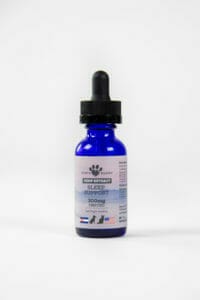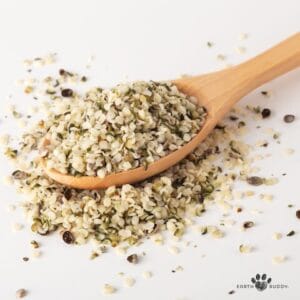Blog | CBD FAQ's | CBD Pet Edibles | Dogs
Cannabinoids and Terpenes for Pet Health
July 11, 2022
Written By: Earth Buddy Team

Known for its spicy, earthy flavor, Beta-caryophyllene is one of the most abundant terpenes in Earth Buddy’s hemp plants. Also found in black pepper and cinnamon, this terpene supports a healthy inflammatory response in the body, promotes the body’s innate resistance to pathogens and more.
Part 3 of our mini-series introduction to CBD For Pets
Welcome, everyone! You have arrived at the final installment of our 3-article introduction to CBD for Pets.
If you have followed each part of this series, you arrive here with a deeper understanding of what CBD is and how it supports your pet’s health–in ways such as promoting a state of calm, maintaining a healthy inflammatory response and more.
You may recall mentions of other compounds found within the Cannabis plant–beyond CBD–such as terpenes and other cannabinoids. In this article, the Earth Buddy team dives further into the Cannabis plant’s structure and how terpenes and cannabinoids for pets can contribute to CBD’s role in their health..
This article is the final of 3 which make up a mini-series introduction to CBD for pets. To get a better understanding of CBD for pets, visit Earth Buddy’s blog for the prior two articles, How to Use CBD for Pets and How CBD Calms Your Pet.
Where Does CBD Come From?
The Cannabis plant is an herb that can grow to reach between 1.5 to 35 feet tall. The male and female plants look mostly alike: varying shades of green, one main stem, and branches with jagged, fan-like leaves comprising up to 13 fingers.
Where the sexes differ is that the female actually flowers (the male simply buds). It is on the females’ flowers that are beautiful, crystal-like coatings called “trichomes” exist. These barely visible trichomes are where the medicinal compounds are produced.
So, when you hear of THC, CBD or any medicinal use of cannabis, it is most likely the female plant that is being referred to (the male plant’s components are usually used for hemp textiles, breeding and other non-medicinal reasons).
Let’s take a further look into the medicinal compounds made by the female plant.
The Components of the Cannabis Plant
Since we have already mentioned the more widely known compounds, THC and CBD, it is worth noting that these two belong to one type of medicinal compound found in the cannabis plant: cannabinoids.
Yet there are over 400 distinct chemical compounds found within the cannabis plant, which fall under the following categories:
- Cannabinoids
- Terpenes
- Flavonoids
- Lipids
- Omega Fatty Acids
- Chlorophyll
Our focus for today’s article will be looking at the medicinal properties of cannabinoids and terpenes. Let’s begin a dive into those now.
Medicinal Compounds of the Cannabis Plant
Of the hundreds of compounds found in the cannabis plant, two overarching categories are being widely investigated for medicinal properties: cannabinoids and terpenes.
Cannabinoids:
One of the most fascinating things about cannabinoids is that they are not only made in plants–they are also made in the body (both yours and your pets’!).
The cannabis plant produces around 100 different cannabinoids–some of which you may have heard ad nauseum (CBD and THC), and some of which you may have never heard of before (CBN, CBG, etc.). Below are a few of the more widely seen cannabinoids at this time:
- THCa and THC: tetrahydrocannabinolic acid is the most widely found component of the cannabis plant. Once heated, THCa converts to the non-acidic form of the molecule widely used and known as THC. THC is known for inciting an intoxicating feeling. It has medicinal benefits for pets such as helping occasional discomfort, supporting inflammatory response and more.
- CBDa and CBD: cannabidiolic acid is the second most prevalent component of the cannabis plant. Like THCa, CBDa is the acidic form of the molecule which is then heated to convert to the non-acidic version–CBD–used amongst humans and pets. It is non-psychoactive, non-addictive, and has been known to support a variety of functions in the body such as immune response, inflammatory response, digestive health, stress management and more.
- CBC: cannabichromene is non-psychoactive and has been known to support digestive and nervous system function, as well as a healthy inflammatory response.
- CBN: cannabinol is mildly psychoactive and supports healthy inflammatory response, nervous system function and the body’s innate ability to fight pathogens.
- CBG: cannabigerol accounts for less than 1% of the cannabis plant. It is non-psychoactive and supports healthy inflammatory response, nervous system function and the body’s innate ability to fight pathogens.
RECOMMENDED PRODUCT: Sleep Support 300mg CBN:CBD
Cannabinol (CBN) is a heat activated molecule that has shown to help with restlessness and promotes a calming effect for pets. The combination of high CBN and low CBD provides a unique and abundant blend of plant molecules creating a synergistic effect that cannot be achieved by single-molecule products. CBN is mildly psychoactive, which can help pets cope with external stresses.
- Helps maintain contentment during separation, travel, motion sickness, and tension caused by changes in your pet’s daily routine
- Supports normal recovery from stress
- May reduce hyperactivity & promote relaxation
- Whole Plant Hemp Extracts with a full-spectrum of CBD, CBN cannabinoids and terpenes are blended into organic MCT (medium-chain triglycerides) oil from coconuts and grapeseed
- Plants grown at high-elevation under the rocky mountain sunshine with clean water from glacial melt
- All products subjected to rigorous third-party lab testing for potency and impurities
Terpenes:
Do you appreciate the smell of rosemary, a lemon rind or a pine tree? You can thank terpenes for that.
Unlike cannabinoids, terpenes are compounds found in many plants throughout the world.
Terpenes are designed by the plant’s unique exposure to light, and give each plant its own distinct smell and flavor.
While these traits form a protective resource for the plants, attracting pollinators and warding off unwanted visitors, terpenes have been found to host a variety of medicinal properties for pets as well. Below are a few of the terpenes found in cannabis:
- Limonene: has a citrus aroma and is found in fruit rinds and peppermint. This terpene supports the central nervous system, among other parts of the body.
- Pinene: contains a pine aroma and is also found in pine needles and rosemary. This terpene also supports the central nervous system as well as healthy inflammatory response.
- Myrcene: has an herbal, earthy aroma and is found in sweet basil, mango, lemongrass and more. This terpene supports the central nervous system and healthy inflammatory response.
- Linalool: has a floral aroma and is present in lavender. This terpene is known for promoting a state of calm.
- Ocimene: contains a sweet and woodsy aroma, and is present in parsley and mint. This terpene supports healthy inflammatory response.
- Humulene: contains a woody and spicy aroma and is found in sage, ginseng, hops and more. This terpene supports healthy inflammatory response and the body’s natural ability to fight pathogens.
Like cannabinoids, terpenes for dogs and cats contain an array of health benefits for pets and are still being studied.
The Benefits of a Full Spectrum CBD Product for Our Pets
At this point, you may be considering the inclusion of terpenes and other cannabinoids in your pet’s next CBD product.
While there is still much to discover about the components of the cannabis plant, studies have shown that the inclusion of more than one component enhances the benefits of the others.
Next time you purchase CBD, look for a breakdown of what other cannabis components are included. If you do not see any, you can ask your supplier for a Certificate of Analysis, which may list the various cannabinoids and terpenes in the product.
Footnotes & Sources:
- https://www.findlaw.com/criminal/criminal-law-basics/is-cbd-legal.html
- https://www.akc.org/expert-advice/health/cbd-oil-dogs/
- https://www.frontiersin.org/articles/10.3389/fnins.2018.00730/full?fbclid=IwAR0gaQdlH4nvbJ6oTDs4WydQsSj4fHxclpmOhgaJfE9CQmwMV5EUu1xYRVU#B59
- https://pubmed.ncbi.nlm.nih.gov/28249817/
- https://pubmed.ncbi.nlm.nih.gov/20002102/
- https://journals.sagepub.com/doi/10.1177/0269881110379283
You Might Also Enjoy
Learning how to calm a dog down is an essential skill to have in your…
Whole foods are integral to a dog’s diet, offering unprocessed, natural nutrients that promote and…
Hemp seeds, harvested from the hemp plant known as Cannabis sativa, have become known as…







